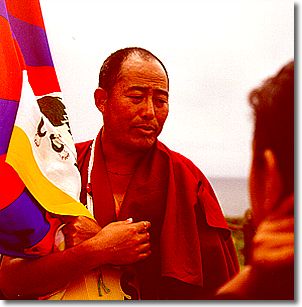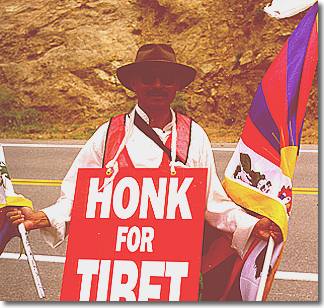
Free Tibet!
By Andrea
Perkins
(Photos by Andrea Perkins and Deyaa Mounir)
Activism is a beloved American occupation. All that is required is a good cause and enough physical strength to lift a picket sign. And Californians seem to warm to protests and demonstrations. Take for example Kate and Greg Bates of Carmel. They don't look as if they would be radical or alternative, but these two recent retirees have nothing but good things to say about the flag-waving, slogan-shouting group that has just traipsed through their exclusive neighborhood on a quiet Saturday afternoon.
"Almost makes me want to join them," says Greg, 74, brandishing his walker.
"We've never had this kind of support," says Julie Crow (right), member of the International Tibet Independence Movement. "People in California have been so hospitable, knocking themselves out to accommodate us and set up programs."
During the months of April, May and June, the Indiana-based group is crossing the Golden State on foot. Sixteen people, from all over the world, have left their jobs and families to walk the 525 miles from San Francisco to Los Angeles. Led by Tibetan refugee leaders and former political prisoners Ani Palchen Dolma, L. Pema Lhundrup and Yeshe Todgen (bottom of page, left), the group swelled to 200 as it passed through downtown San Francisco on April 25. People have joined its ranks every day, walking for as long as they can before returning to their obligations.
This is the group's fifth and largest walk since its founding. The goal: to educate the public and rally support for the beleaguered nation of Tibet.

Though intended to start on the 11th birthday of the Panchen Lama, the world's youngest political prisoner, and to end on the day before the Dalai Lama's arrival in Los Angeles, this year's march also happened to coincide with the vote in Congress on granting "normal trading relations" to China.
The protest has a long pedigree, echoing the spirit of Gandhi's nonviolent peace marches, says Benjamin Cox, the group's director. "Tibetans also relate to it,'' he says, "because many had to walk out of Tibet through the Himalayas, which took at least three months."
"Many people think Tibet is an isolated case," adds Tsewang Khangsar (bottom of page, right), vice president of the Tibetan Association of Northern California. Khangsar, a Tibetan native currently residing in Albany, Calif., quit his job to come on the march. "It is not. Tibet is the key to free China. To free China is to free one-fourth of the world's population, which right now is under totalitarian regime. This should be a big concern for everyone."
China, of course, has caused much concern in Washington. The question has been, does the United States want to free a quarter of the world's population from a totalitarian regime guilty of endless human rights violations, or is the priority to exploit its tempting market opportunities? At least that has been the way many have seen the issue.
The International Tibet Independence Movement has actively boycotted Chinese products since 1994. "All we do when we spend money in China is give an oppressive government the means to oppress the people even more," says one demonstrator, Julie Crow, a divorced mother of two who works with disabled children for a living.
Loud cries of "Free Tibet! Free Tibet!" erupt from the marchers, walking in careful single file along the thin margin of narrow Highway 1. Cars slow and show support by honking. Flags are waved exuberantly. Walking an average of 15 miles a day, 6 days a week, may make the protesters' feet ache, but it bolsters their spirits.
"My feet are actually doing OK," says Benjamin, "I've got my Pumas, made in Slovakia. Not China, that's key. It's not that we're anti-China, we're just anti forced labor and sweat shops."
Two Tibetans pull up with lunch for the walkers, having risen before dawn and driven four hours from their home in Berkeley to get here. Unable to quit their jobs or leave their families to join the march, many participants have shown up sporadically to show their support in this way.
"Not feeding us, force-feeding us," says Jeff Napier with gratitude. A veteran member of the group, he is elaborately tattooed with pictures of Indian deities and the Tibetan word for liberation, "rangzen."
"One person shouted 'Get a job!' at us yesterday," says Crow. "That was near Salinas. Other than that, there hasn't really been any negative response, besides a few comments from white guys in trucks. But that has happened a lot less often in California than on walks in other states."
So why California? Julie Crow explains, "When we asked His Holiness the Dalai Lama where would be a good place to walk, he said, 'Oh, maybe California -- or Eastern Europe.'"
The rest is history. The group is already seeing positive consequences from its California campaign. After a rally at the University of California at Santa Cruz, Representative Sam Far, a Democrat of Santa Cruz, announced that he would refuse to support normalized trade relations with China, following up with an official announcement to that effect the next day.
"He cited our walk as a mitigating factor in his decision," says Crow.
It's raining pretty heavily now, but the protesters show no signs of slowing. Tonight, they will sleep at the Grange Hall in Big Sur, a building used primarily for farmers' meetings. So far, they've stayed in a variety of shelters, from private homes in Pacifica to Episcopal churches to study rooms at Stanford. Tonight, Tibetan monks from Monterey have offered to come and cook them dinner.
"We're probably going to actually gain weight on this march," says Benjamin, with a smile.


